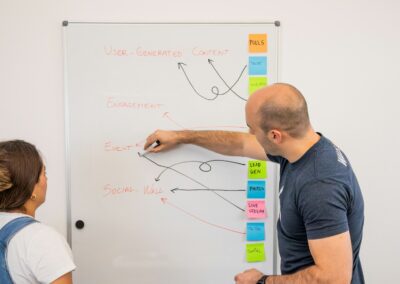Expanding the Horizons of Virtual Reality Social Platforms
The Rise of VR Social Networks
Scaling VR social networks has become a crucial topic as virtual reality platforms gain popularity. These networks offer immersive experiences where users can interact in three-dimensional virtual spaces, creating new opportunities for social interaction, collaboration, and entertainment. However, as the number of users on these platforms grows, so do the challenges associated with maintaining performance, ensuring user experience, and managing technical constraints.
In regions like Saudi Arabia and the UAE, where technological adoption is high and innovation is prioritized, VR social networks are gaining traction. Cities like Riyadh and Dubai are becoming hubs for VR development, attracting investments and talent to advance this technology. The challenge lies in scaling these networks to accommodate a large number of users without compromising the quality of the experience. This involves addressing issues related to server capacity, network latency, and the overall architecture of VR platforms.
One of the primary challenges is ensuring that the infrastructure can support simultaneous connections from a vast user base. This requires robust server infrastructure and efficient data management practices. In addition, network latency must be minimized to provide a seamless experience for users, as any delay can significantly impact the immersive nature of VR interactions. Addressing these technical challenges is essential for the growth and success of VR social networks in technologically advanced regions like Saudi Arabia and the UAE.
Technical Challenges in Scaling VR Social Networks
The technical challenges of scaling VR social networks are multifaceted, involving server infrastructure, data synchronization, and user interface design. One significant challenge is managing the server load as the number of concurrent users increases. VR experiences require substantial computational power and bandwidth, as each user’s movements and interactions must be rendered in real-time. Ensuring that servers can handle this load without degradation in performance is critical.
Data synchronization is another major issue. In a VR social network, users interact with each other and the environment in real-time, meaning that any lag or inconsistency in data transmission can disrupt the experience. Synchronizing data across multiple servers and ensuring that all users see the same virtual environment at the same time requires sophisticated algorithms and robust network infrastructure. This challenge is compounded when users are spread across different geographical locations, as network latency can vary significantly.
User interface design also plays a crucial role in scaling VR social networks. The interface must be intuitive and responsive, allowing users to navigate and interact with the virtual environment effortlessly. This involves optimizing the design for various VR hardware and ensuring compatibility across different devices. In regions like Dubai and Riyadh, where users may have access to the latest VR technology, maintaining a high standard of user experience is essential to meet the expectations of a tech-savvy audience.
Strategies for Overcoming Scaling Challenges
To overcome the challenges of scaling VR social networks, several strategies can be employed. First, leveraging cloud computing can provide the necessary computational power and flexibility to handle large numbers of users. Cloud-based servers can be scaled up or down based on demand, ensuring that resources are available as needed. This approach also allows for distributed data processing, which can help minimize latency and improve performance.
Second, implementing advanced network protocols and optimization techniques can reduce latency and improve data synchronization. Techniques such as edge computing, where data processing occurs closer to the user’s location, can significantly reduce the time it takes for data to travel across the network. This can enhance the responsiveness of VR interactions and ensure a smoother user experience.
Third, continuous monitoring and optimization of the VR platform are essential. This involves regularly assessing server performance, network latency, and user feedback to identify areas for improvement. By adopting a proactive approach to maintenance and optimization, VR social networks can ensure that they remain scalable and responsive as the user base grows.
In technologically progressive regions like Saudi Arabia and the UAE, investing in these strategies can help overcome the challenges of scaling VR social networks. By leveraging cutting-edge technology and adopting best practices in network management and optimization, businesses can create robust and scalable VR platforms that accommodate large numbers of users while maintaining a high-quality experience.
The Role of AI and Blockchain in Scaling VR Networks
Artificial intelligence (AI) and blockchain technology offer innovative solutions for scaling VR social networks. AI can be used to optimize network performance and manage server loads more efficiently. Machine learning algorithms can predict usage patterns and adjust resources accordingly, ensuring that server capacity is always aligned with demand. AI can also enhance the user experience by providing personalized content and interactions based on individual preferences and behaviors.
Blockchain technology can address some of the security and data management challenges associated with scaling VR social networks. By providing a decentralized and secure method for data storage and transmission, blockchain can ensure that user data is protected and transactions are transparent. This is particularly important in a VR environment where users may be exchanging virtual goods or currencies. Blockchain can also facilitate decentralized applications (dApps) that operate independently of a central server, reducing the load on the main network and improving scalability.
For business executives and entrepreneurs in Riyadh, Dubai, and other tech-forward cities, integrating AI and blockchain into VR social networks can provide a competitive edge. These technologies not only enhance scalability but also offer new opportunities for innovation and differentiation. By staying at the forefront of technological advancements, businesses can create VR platforms that are robust, secure, and capable of supporting large, active user communities.
Conclusion: The Future of Scaled VR Social Networks
In conclusion, scaling VR social networks to accommodate large numbers of users involves addressing significant technical challenges and leveraging advanced technologies. By investing in robust server infrastructure, optimizing network performance, and integrating AI and blockchain, businesses can overcome these challenges and create scalable, high-quality VR platforms. For regions like Saudi Arabia and the UAE, where innovation and technological adoption are driving economic growth, the successful scaling of VR social networks represents a significant opportunity.
As VR technology continues to evolve, the potential for immersive social interactions and collaborative experiences will expand, offering new avenues for business and personal engagement. By prioritizing scalability and user experience, VR social networks can achieve long-term success and become integral to the digital landscape in technologically advanced regions. Embracing these advancements will not only enhance the user experience but also position businesses at the forefront of the next wave of digital innovation.
—
#ScalingVRSocialNetworks #VirtualReality #VRSocialNetworks #UserEngagement #ModernTechnology #ArtificialIntelligence #Blockchain #TheMetaverse #SaudiArabia #UAE #Riyadh #Dubai #ExecutiveCoaching #BusinessSuccess #LeadershipSkills #ProjectManagement























